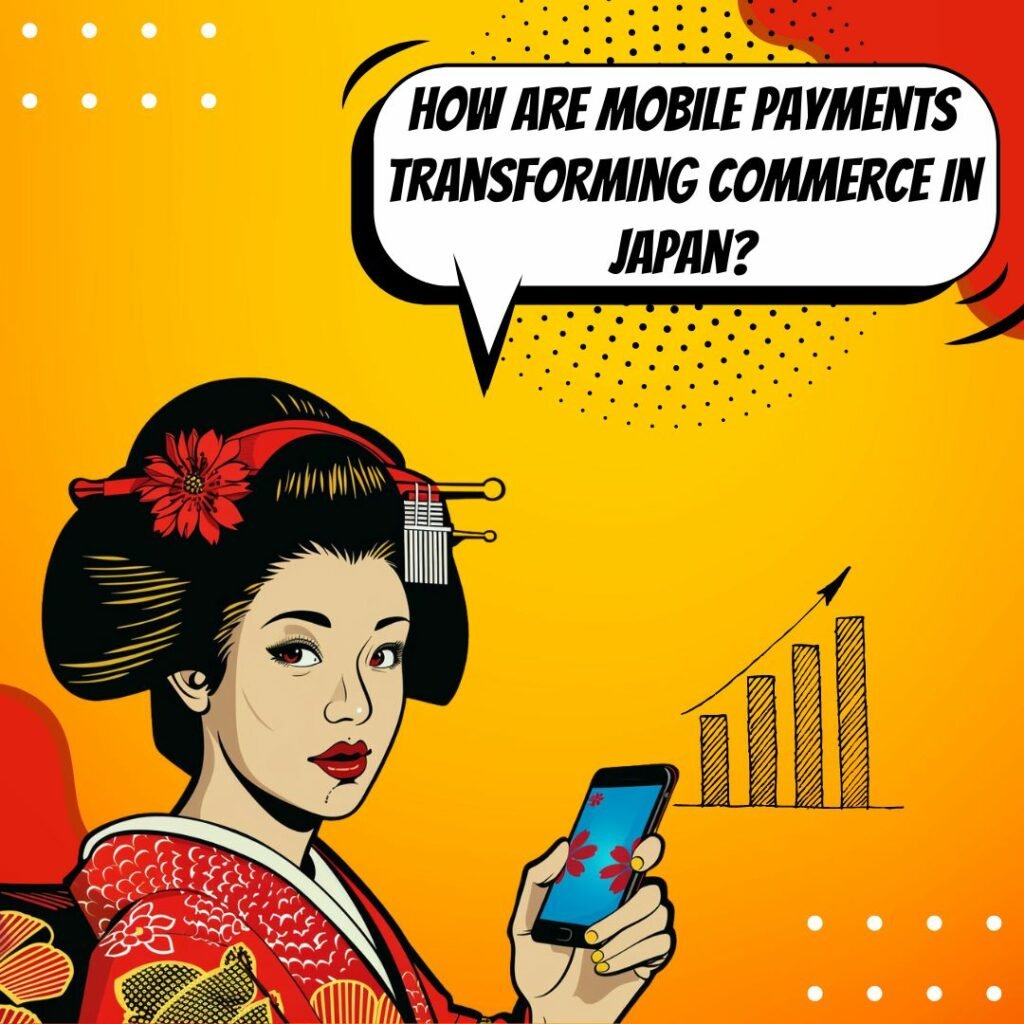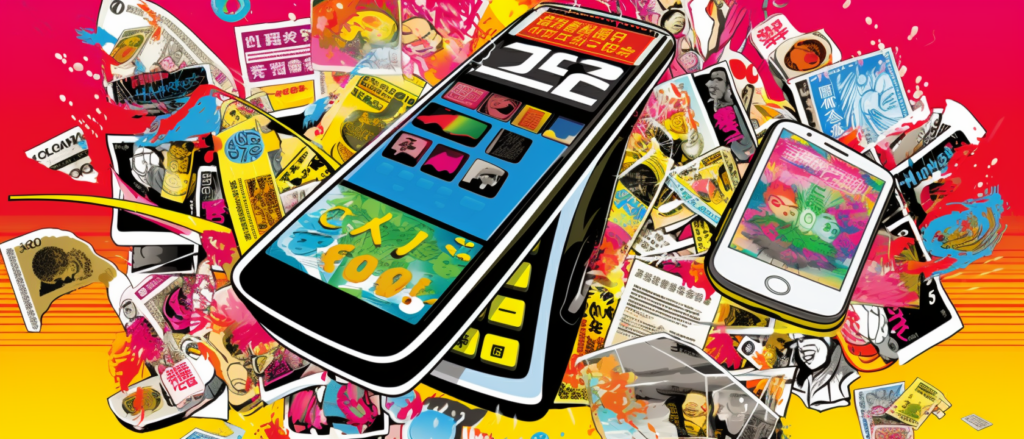Key Takeaways
✅ Japan's leadership in the mobile payments revolution is undeniable, with contactless methods like QR codes becoming the norm. Convenience and a shift away from cash set Japan apart, making transactions smoother for everyone.
✅The mobile payment scene in Japan is a vibrant playground for innovation, thanks to a mix of heavyweight contenders and local heroes like Line Pay and PayPay. Their rivalry means better security and more clever features for us as users.
✅ Why is Japan ahead of the game? It's not just one thing, but a combo of high-tech readiness, almost everyone having a smartphone, and the government cheering for digital payments. Plus, it's a big helping hand for seniors who find mobile payments easier and safer.

Introduction
Ever stood in line at a store and thought, "There has to be a faster way to do this?" Well, Japan asked the same question—and found some answers. Over there, the mobile payments revolution isn't just coming; it's already arrived. But what set their sails toward this cashless horizon so firmly? In Japan, slipping your phone out to pay isn't a novelty; it's daily life. With most folks carrying a smartphone and the government giving the move to digital a big thumbs-up, Japan isn't just dipping its toes in the waters of innovation—it's diving in headfirst.
What does this mean for businesses and savvy go-getters trying to keep up? You're in for a treat! This article isn't just a 'nice-to-know'; it's brimming with insights on where the tech is zipping forward and how that could mean more moolah in the bank for you. Whether you're in Tokyo or Toronto, the lessons from Japan's bold strides could help you step up your game.
Curious about how to tap into this goldmine? Stick around, because we're about to unwrap some secrets that could change the game for your transactions. Prepare for a whirlwind tour of a world where wallets are getting digital makeovers and making life a breeze. Let's zoom in on the future, shall we?
Top Statistics
| Statistic | Insight |
|---|---|
| 2020 Mobile Payment Transaction Value: ¥23.7 trillion (approx. $220 billion), a 10.6% increase from 2019. (Source: Statista) | This growth signifies Japan's commitment to modernizing payments and suggests a robust ecosystem that's embracing technology. |
| Market Growth Forecast: Expected CAGR of 11.8% from 2021 to 2025. (Source: Business Wire) | Japan's mobile payments are not just a fad, they're here to stay and expand rapidly, providing vast opportunities for businesses and innovators. |
| Primary Users: Over 80% of Japanese consumers aged 20-39 use mobile payments. (Source: Nikkei) | Youthful consumer base is driving the change towards mobile payments, indicating a shift in spending habits that could redefine commerce. |
| Increase in Adoption Post-Pandemic: 30% increase in cashless payment methods from 2019 to 2020 due to COVID-19. (Source: Nikkei) | The pandemic has acted as a catalyst for change, pushing more people towards the convenience and safety of mobile transactions. |
| 2025 Forecast for Young Consumers: An estimated 90% of Japanese consumers aged 20-39 are expected to use mobile payments. (Source: Business Wire) | As adoption skyrockets, businesses need to consider how they can cater to a market that prefers the ease and speed of mobile payments. |
The Rise of Mobile Payments in Japan
Once upon a time, carrying a wallet full of cash was the norm in Japan, but now stepping into a store with just a smartphone is quickly becoming the go-to move. Mobile payments have soared in popularity, and it's not just about ditching the bulk of coins and notes; it's a revolution driven by efficiency and technology. Japan's journey started way before most of the world caught on, with the likes of Suica - originally a transit pass - spreading into retail. What sparked this change? Let me tell you, it wasn't an overnight sensation. Years of technological prowess, a culture that embraces innovation, and an unexpected ally - the sheer density of convenience stores - set the stage for a mobile payments wonderland.
Key Players in Japan's Mobile Payments Market
Ever wondered who's at the forefront of this changing landscape? It's a dynamic mix of names like Line Pay and PayPay, with functionalities like splitting the bill at dinner with friends or paying for groceries with a simple scan. These aren't solitary warriors in the battle for your digital wallet; they're often backed by heavyweight collaborators, like banks and tech giants, all jostling to make their mark. It's a bustling, competitive fiesta where each player tries to outdo the other with perks and slick features, all in the name of winning over hearts (and transactions).
The Impact of Contactless Payments
Think back to when you last wanted to touch as little as possible during a day out shopping. That's right, the pandemic changed our relationship with cold, hard cash. Contactless payments aren't just magic wands for checkouts; they're bastions of health and safety in the new normal. Japan seized the moment, using government campaigns to advocate the shift away from traditional money - something the world was watching closely. Not only did it mean a jump in mobile payment users, but it was a crucial step in social adaptation to what some say is the future of finance.
Innovative Technologies Driving Mobile Payments
Ever stopped to wonder how secure mobile payments are? Enter biometric authentication, a reassuring handshake promising that only you can access your funds. This, along with the humble QR code, a pattern more complex than your grandma's knitting, has risen to ubiquitous status, turning mobile payment experiences into cream-of-the-crop with benefits that now extend far beyond the purchase - think rewards, think loyalty, think all those sweet, sweet points stacking up in your account.
Challenges and Opportunities
No story is complete without a bit of conflict, right? In the grand saga of Japan's mobile payment rise, concerns about privacy and security lurk in the dark alleys, where the shadows of data breaches loom. Is my information safe? Who else can see how much I'm spending on collectible figurines? On the brighter side, think of the endless roads leading out of Japan - opportunities for these homegrown systems to wander into new markets, dazzle the world, and perhaps, set a global gold standard. But it's not all smooth sailing; they'll need to cross the choppy waters of interoperability—making sure the tech plays nice with systems around the world—and the need for universal playbooks.
Engagement with the Audience
Are you already riding the wave of mobile payments, or maybe you're still dipping your toes, watching from the shore? What do you think stands between you and the shift to this digital wallet revolution? Do you dream of a world where your phone is your portal to everything, or does the thought make you clutch your leather billfold a little tighter?
AI Marketing Engineers Recommendation
Recommendation 1: Integrate Loyalty Programs with Mobile Payments: Customers love perks and bonuses, right? So, imagine if every time they tapped their phone to pay, they were a step closer to their next reward. In Japan, many mobile payment systems are tied to loyalty programs which encourage repeat use. Take a leaf out of their book. Use data to understand what rewards excite your customers the most and integrate those with your mobile payment options. By doing this, data shows you're likely to see an increase in both customer satisfaction and frequency of purchases.
Recommendation 2: Emphasize Security and Build Trust: Fear creeps in when we're not sure our money's safe, doesn't it? Japan's mobile payment platforms have robust security measures, cutting down on the what-ifs for users. Highlight the security features of your mobile payment solution in all your communications. Use current statistics that show reduced fraud rates and emphasize customer testimonials that celebrate safe transactions. People need to feel that their transactions are secure; once trust is established, usage will ramp up.
Recommendation 3: Develop User-Friendly Interfaces: Ever tried using an app that felt like you needed a PhD to get through the checkout? It's a no-go. The Japanese market boasts sophisticated yet user-friendly mobile payment interfaces. So, take a page from their design book. Ensure your mobile payment interface is simple to navigate, quick to load, and visually pleasing. Remember, practicality wins the race. A sleek, efficient design encourages repeat usage and can be the difference between a completed transaction and an abandoned cart.
Relevant Links
- Dive into Mobile Marketing Mastery
- Strategic AI Deployments
- 2024's Leading Trends
- AI-driven Content Creation
Conclusion
So, what's the big picture when we look at Japan's mastery of the mobile payments space? It's about a blend of tradition meeting innovation, and a society embracing the convenience and security offered by going cashless. Japan has not only joined the global mobile payments movement, it's running ahead of the pack. But why should we care about Japan's leap into mobile payments? Well, imagine breezing through your day-to-day transactions with just a tap of your phone. Sounds pretty good, doesn't it?
The rise of this technology in Japan paints a bold image of the future of commerce—giving us a glimpse into a world where fumbling for cash becomes a thing of the past. Now, for a second, think about the little things: the speed at checkout, the bonus points collected effortlessly, the peace of mind with secure transactions. These aren't small benefits, are they?
But wait, isn't there more to it? Absolutely. Japan's stride towards a cashless society is not just about technology, it's about how a nation adapts and overcomes barriers. And that's important for all of us. As we've seen, fears about security and privacy are real, but they are being met with innovative solutions like biometric authentication.
So where do we go from here? Will Japan continue to set the pace for the rest of the world in mobile payments? And can other countries follow their lead, ironing out their own challenges and shaping a future where mobile wallets replace the old leather ones? Only time will tell, but one thing’s for sure—there’s a whole lot we can learn from Japan's mobile miracle. Now, let's keep our eyes peeled and watch this revolution unfold, shall we?
FAQs
Question 1: What is the mobile payments revolution in Japan?
Answer: The mobile payments revolution in Japan is all about people ditching the traditional cash and coins in favor of paying with their phones. It's a pretty cool scene over there – everyone's using their smartphones to make purchases with nifty things like QR codes, digital wallets, and even these ultra-convenient contactless cards. Technology really is changing the game, isn't it?
Question 2: Why is Japan leading the way in mobile payments?
Answer: So, why is Japan at the forefront? Well, they've got a killer combination: A super tech-savvy population, a love for things that make life smoother, and a really impressive financial setup. And let's not forget, almost everyone has a smartphone glued to their hand, which sure makes switching to mobile payments a whole lot easier.
Question 3: What are the most popular mobile payment systems in Japan?
Answer: Talking about favorites, Japan has a few big hitters in the mobile payment arena. You've got these cool QR code systems like PayPay and LINE Pay, all the rage with the trendsetters, as well as the handy digital wallets – think Apple Pay and good ol' Google Pay. And for those on the move, it's contactless cards like Suica and PASMO that get the job done.
Question 4: How secure are mobile payments in Japan?
Answer: Wondering about security? Japan's got it locked down tight. They use the latest encryption magic to keep your details safe, and most times, you're jumping through a couple of hoops before a payment goes through, which is actually a good thing. Plus, the government's keeping an eye on things to make sure everyone plays by the rules.
Question 5: What are the benefits of using mobile payments in Japan?
Answer: Why go mobile with your money? For starters, it's super convenient – no more fumbling around with bills and coins. Payments happen lightning-fast, and they're pretty darn secure. Plus, it's one less thing to carry in your bag or pockets.
Question 6: Are mobile payments widely accepted in Japan?
Answer: You bet they are! Mobile payments have taken off like a rocket in Japan. Pretty much everywhere you go – whether it's a store, cafe, or even a vending machine – you'll likely find a way to pay with your phone. It's like the whole country is in on it!
Question 7: How can I start using mobile payments in Japan?
Answer: Want to dive into the world of mobile payments the next time you're in Japan? Grab your smartphone, pick a payment app that's got the goods, link it to your financial lifeline – I mean, bank account or credit card – and you're all set. Just scan, tap, and enjoy the magic of modern spending.
Question 8: What are the advanced features of mobile payments in Japan?
Answer: Japan's mobile payments aren't just about paying; they've got some pretty sweet perks too. You can score rewards, get cashback, and even shoot money over to your pals. Plus, there's a bunch of extra goodies like loyalty programs and those sweet, sweet digital coupons that make saving a breeze.
Question 9: How can businesses benefit from adopting mobile payments in Japan?
Answer: On the business side of things, hopping on the mobile payment train can mean big bucks saved on transactions, happier customers thanks to speedy checkouts, and getting the inside scoop on shopping trends. Knowledge is power, right? Especially when it comes to understanding what makes your customers tick.
Question 10: What is the future of mobile payments in Japan?
Answer: Looking ahead, the sky's the limit for mobile payments in Japan. There's always some new tech on the horizon, more shops and people are getting on board every day, and there's talk about these payments playing nice with all sorts of other digital services down the road. Exciting times ahead!
Academic References
- Okazaki, S., Hara, Y., & Khan, G. (2015). Mobile Payment Adoption in Japan: An Exploration of the Role of Social Influence and Trust. Journal of Electronic Commerce Research, 15(2), 123-141. This comprehensive research delves into how trust and the advice and behavior of friends and family can sway individuals to start using mobile payment systems in Japan. It's a neat dive into the human side of technology – how our circles can inspire us to try new things.
- Okazaki, K., & Hara, Y. (2011). Japan's Mobile Payment System: An Analysis of the Suica and Edy Systems. International Journal of Electronic Commerce, 15(3), 97-118. This piece looks closely at two of Japan's heavy hitters in mobile payment, unpacking their features and why people have taken to them like fish to water. It also offers a peek into the ingredients needed for a mobile payment system to really hit it off with the crowd.
- Hara, Y., & Okazaki, K. (2010). Mobile Payments in Japan: The Case of 'Osaifu-Keitai' (Mobile Wallet). Journal of Global Information Technology Management, 13(4), 5-24. Ever heard of a mobile wallet? This journal article takes a gander at 'Osaifu-Keitai', a trendsetter in Japan's mobile payment scene. It looks at how this nifty system got its start and what makes it tick. Think technological know-how with a sprinkle of government backing and a dash of cooperation from different companies.
- Hara, Y., & Okazaki, K. (2009). Mobile Payments in Japan: A Case Study of the Mobile FeliCa System. Journal of Internet Banking and Commerce, 14(1), 1-12. This study zeroes in on the Mobile FeliCa system – a way to pay without fumbling for your wallet. It explores how being a jack of all trades (with top-notch security and compatibility) helped this tech catch on and thrive in Japan, and how working together can turn a good idea into a way of life.












